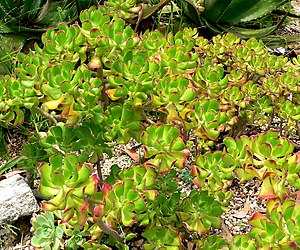Note: This is a project under development. The articles on this wiki are just being initiated and broadly incomplete. You can Help creating new pages.
Difference between revisions of "Sedum dendroideum - Tree stonecrop"
(→List of Ayurvedic medicine in which the herb is used) |
(→How to plant/cultivate) |
||
| Line 52: | Line 52: | ||
==How to plant/cultivate== | ==How to plant/cultivate== | ||
| − | Sedum dendroideum is not a very cold-hardy plant, tolerating temperatures down to around -8°c when dormant<ref name="How to plant/cultivate"/> | + | Sedum dendroideum is not a very cold-hardy plant, tolerating temperatures down to around -8°c when dormant. Can be easily propagated by cuttings. <ref name="How to plant/cultivate"/> |
==Commonly seen growing in areas== | ==Commonly seen growing in areas== | ||
Latest revision as of 10:29, 13 June 2019
Sedum dendroideum is a shrub-like perennial plant and it is Native to Mexico. It has been naturalized to California and Ohio.
Contents
- 1 Uses
- 2 Parts Used
- 3 Chemical Composition
- 4 Common names
- 5 Properties
- 6 Habit
- 7 Identification
- 8 List of Ayurvedic medicine in which the herb is used
- 9 Where to get the saplings
- 10 Mode of Propagation
- 11 How to plant/cultivate
- 12 Commonly seen growing in areas
- 13 Photo Gallery
- 14 References
- 15 External Links
Uses
Hardening of the gums, Haemorrhoids, Chilblains, Dysentery, Nosebleeds.
Parts Used
Chemical Composition
The oral administration (0.1-1g/kg) of the lyophilized Sedum dendroideum juice (L J) caused a significant dose-related reduction of acetic acid-induced writhing response (ID(50)=631 mg/kg) and inhibited croton oil-induced ear oedema formation (66% inhibition at 1g/kg) in mice. In the formalin-induced nociception in mice, L J (1g/kg) only inhibited the second phase of nociception (46%). Phytochemical investigation revealed four known kaempferol glycosides, here, described at the first time for this species[1]
Common names
| Language | Common name |
|---|---|
| Kannada | |
| Hindi | |
| Malayalam | |
| Tamil | |
| Telugu | |
| Marathi | NA |
| Gujarathi | NA |
| Punjabi | NA |
| Kashmiri | NA |
| Sanskrit | |
| English | Tree stonecrop |
Properties
Reference: Dravya - Substance, Rasa - Taste, Guna - Qualities, Veerya - Potency, Vipaka - Post-digesion effect, Karma - Pharmacological activity, Prabhava - Therepeutics.
Dravya
Rasa
Tikta (Bitter), Kashaya (Astringent)
Guna
Laghu (Light), Ruksha (Dry), Tikshna (Sharp)
Veerya
Ushna (Hot)
Vipaka
Katu (Pungent)
Karma
Kapha, Vata
Prabhava
Habit
Identification
Leaf
| Kind | Shape | Feature |
|---|---|---|
| Simple | Leaves are Semi-evergreen and Broadleaf |
Flower
| Type | Size | Color and composition | Stamen | More information |
|---|---|---|---|---|
| Unisexual | 2-4cm long | Lavender | 5-20 | Flowers are Blooms on new wood and Flower Time is summer |
Fruit
| Type | Size | Mass | Appearance | Seeds | More information |
|---|---|---|---|---|---|
| General | 7–10 mm | clearly grooved lengthwise, Lowest hooked hairs aligned towards crown | many | {{{6}}} |
Other features
List of Ayurvedic medicine in which the herb is used
Where to get the saplings
Mode of Propagation
How to plant/cultivate
Sedum dendroideum is not a very cold-hardy plant, tolerating temperatures down to around -8°c when dormant. Can be easily propagated by cuttings. [3]
Commonly seen growing in areas
Temperate area, Arid climates, Cooler climates.
Photo Gallery
References
External Links
- Ayurvedic Herbs known to be helpful to treat Hardening of the gums
- Ayurvedic Herbs known to be helpful to treat Haemorrhoids
- Ayurvedic Herbs known to be helpful to treat Chilblains
- Ayurvedic Herbs known to be helpful to treat Dysentery
- Ayurvedic Herbs known to be helpful to treat Nosebleeds
- Herbs with Flowers used in medicine
- Herbs with common name in English
- Habit - Evergreen shrub
- Index of Plants which can be propagated by Seeds
- Index of Plants which can be propagated by Cuttings
- Herbs that are commonly seen in the region of Temperate area
- Herbs that are commonly seen in the region of Arid climates
- Herbs that are commonly seen in the region of Cooler climates
- Herbs
- Crassulaceae





